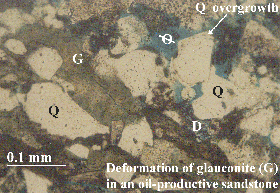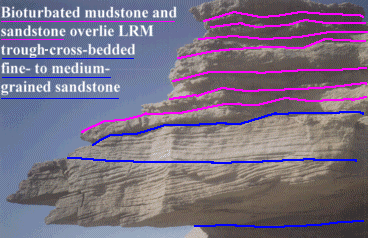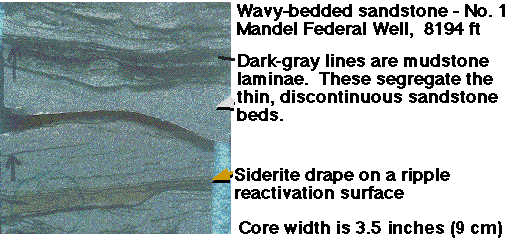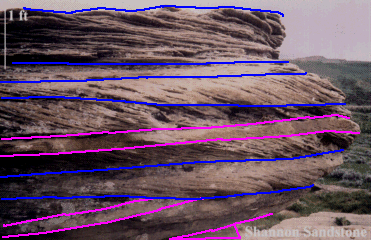Figure 10. This transmitted-light thin-section image is from 8,014 ft (2,443 m) depth in the Empire-Federal "C" oil well. Deformation of glauconite (G) pellets and other soft sediments in trough-cross-bedded sandstones form microscopic and macroscopic permeability baffles to fluid flow. Note also that quartz (Q) grains surrounded by glauconite do not exhibit the later-diagenetic quartz cementation. Mudstone (brown) and glauconite (green) are concentrated along the lower-depositional-energy laminae of trough-cross-bedded sandstones. Late-diagenetic dolomite cement is stained dark blue (D). Medium-blue epoxy fills pore spaces (ellipse with a line through it). Glauconite is 1.4 MB thin section (glauts.gif) image.
Figure 11. Photograph of an outcrop of Sussex Sandstone Member low-energy-ridge-margin (LRM) sandstone; outcrop is located in NW. corner of sec. 7, T. 40 N., R. 78 W., Natrona Co., Wyoming. LRM thickness is about 1 ft (0.5 m). Greater dispersal of glauconite, clays, and mud in lower depositional energy facies decreases porosity and permeability. This thin trough-cross-bedded sandstone, and the bounding burrowed and bioturbated sandstone/mudstone facies, contain mudstone and glauconite laminae and beds that are preferentially eroded, causing greater relief. Blue and purple lines in this small-scale image separate bedding planes. Trough cross-bedded sandstone 1 MB (ssxcrp2.gif) outcrop image.
Figure 12. Core photograph of trough-cross-bedded medium-grained sandstone from 8,169-ft depth in the No. 1 Mandel-Federal well. Depths are in feet. Arrow points up. Siderite (S) clasts are concentrated on the bedding planes. Trough cross-bedded sandstone 512 KB (trs8169.gif) core image.
Figure 13. Core photograph of wavy-bedded fine-grained sandstone from 8,194 ft depth in the No. 1 Mandel-Federal well. Dark lines are mudstone laminae that segregate the thin, discontinuous sandstone beds. A siderite drape (arrow) is located on a ripple reactivation surface. Core width is 3.5 inches (9 cm). Arrows within core point up-hole. Wavy-bedded sandstone - 688 KB core (wss8194.gif) image.
Figure 14. Core photograph of a bioturbated very fine grained sandstone from 8,038-ft depth in the No. 1 Empire Federal well. This facies exhibits very low porosity and low permeability and is a reservoir seal. Black arrow points to a mudstone lamina. Gold arrow shows a burrow trace. Core width is 2 inches. Bioturbated siltstone - 800 KB core (bss8038.gif) image.
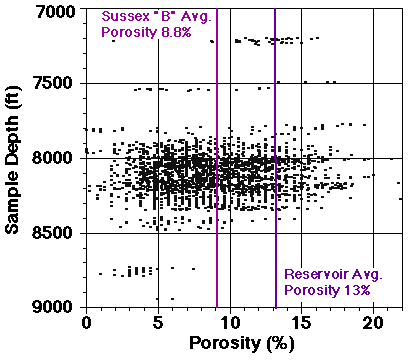
Figure 15. Graph of core and well-log porosity versus depth for 2,600 Sussex Sandstone Member points. The average 8.8 percent porosity of the Sussex "B" sandstone and of reservoir intervals (13 percent) is also plotted. Scatter in data is considerable.

Figure 16. Volume percent porosity and permeability for 791 core plug samples for 30 wells, Sussex Sandstone Member (Higley, 1994). Greater porosity correlates with permeability increase. Scatter in data is considerable. Dotted green lines are geometric averages for this data of 8.8 percent porosity and 0.62 mD permeability. Dashed red lines represent average porosity and permeability of 13 percent and 15 mD for reservoir intervals of the "B" sandstone. Yellow circles surround average porosity and permeability values for sand-ridge facies determined from core examination of 8 wells. Sandstone facies are: chert-pebble lag, C; central-ridge, R; high-energy ridge-margin, H; low-energy ridge-margin, L; wavy-bedded, W; inter-ridge sandstone, S; and burrowed inter-ridge sandstone and mudstone, b.
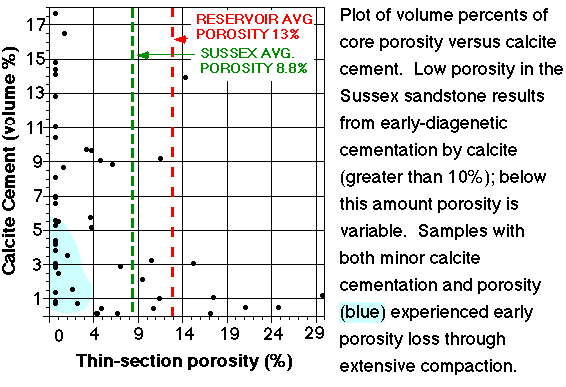
Figure 17. Plot showing volume percentages of core porosity and calcite cement for the Sussex "B" sandstone. Low-porosity sandstones associated with greater than 10 percent calcite cement commonly contain no effective porosity. This occurs mainly during the earliest stage of calcite cementation. The region with low porosity and minimal calcite cementation results from early diagenetic compaction. These samples are primarily burrowed and bioturbated sandstone and mudstone.
Figure 18. This outcrop of a Shannon Sandstone Member trough-cross-bedded sandstone is located at Shepperson Ranch, west of Midwest and Edgerton, Wyoming (figure 1). The thin, low-porosity, quartz-cemented beds are outlined in purple in this small-scale view. Porous and permeable intervals are bounded by a blue line. The 1.2 MB image is named snncrp1.gif .
